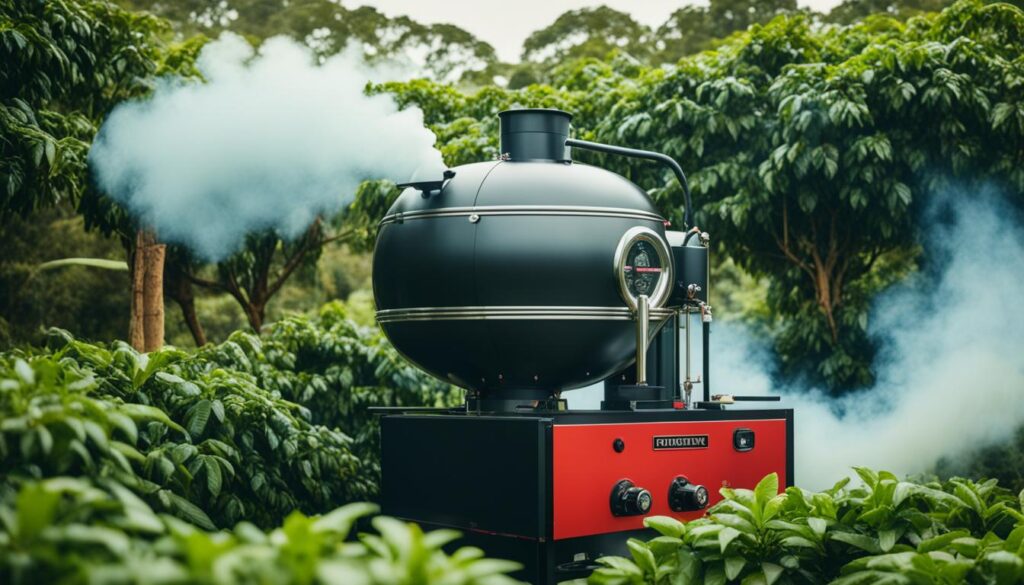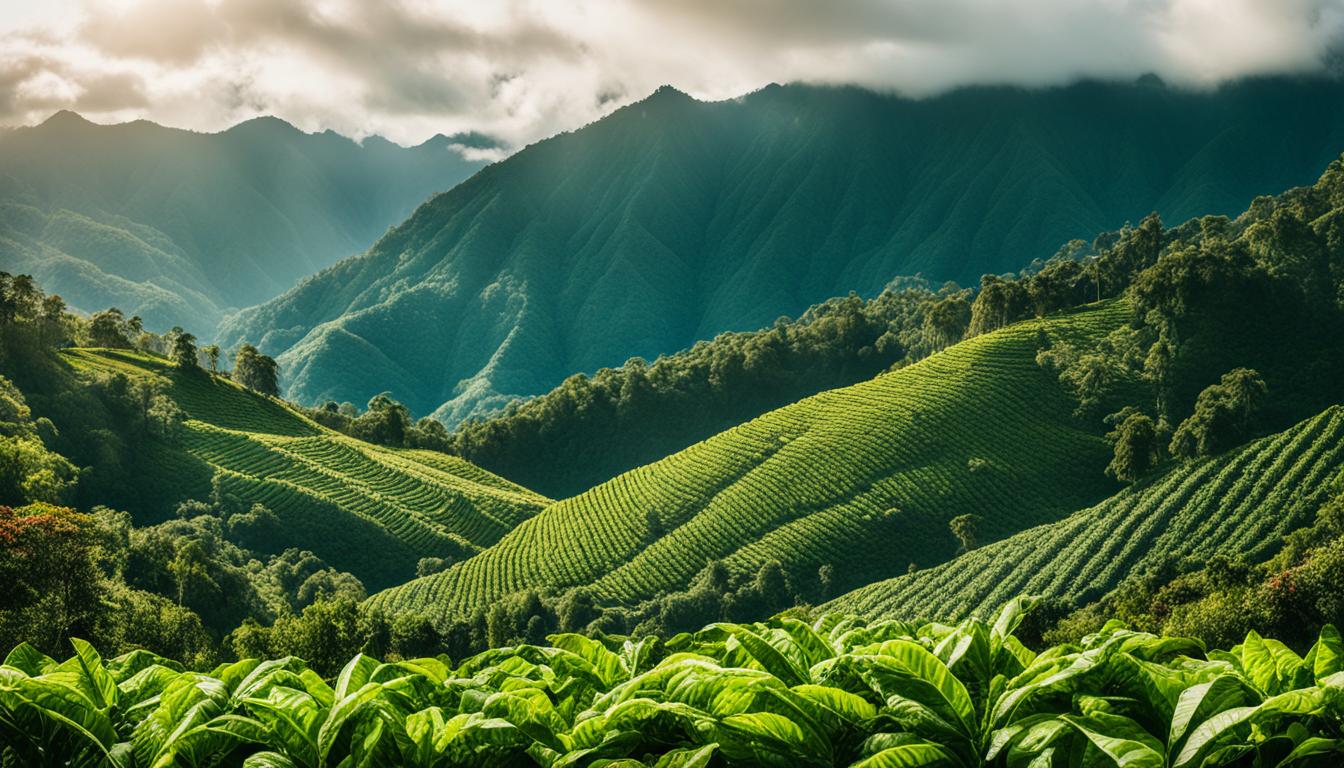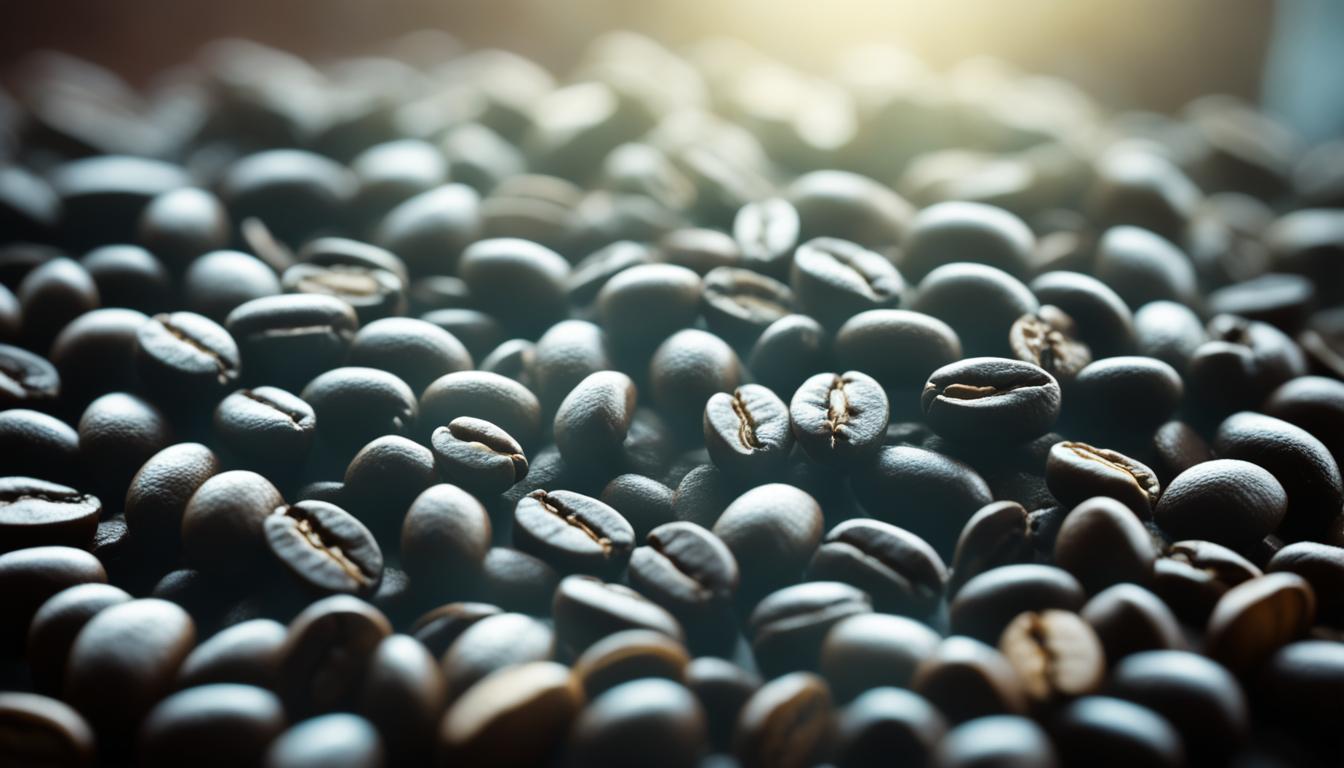When it comes to specialty coffee, there is so much more to discover beyond a simple cup of joe. The world of coffee is rich with diversity, thanks to the concept of coffee terroir. Terroir refers to the various environmental factors that contribute to the unique flavors and aromas of coffee, making each cup a distinct experience.
Coffee terroir encompasses a range of factors, including the soil composition, climate, topography, and biodiversity of the regions where coffee is grown. These elements, along with coffee cultivation techniques and traditions, come together to shape the flavor profile of the beans.
From the coffee-growing regions around the world to the aroma factors, coffee terroir plays a significant role in determining the character and quality of the beans. The specific soil composition affects nutrient availability and flavor compound development, while climate factors like temperature and rainfall impact the growth and development of coffee cherries.
Understanding coffee terroir allows us to appreciate the diverse flavors that arise from different single-origin coffees. Each region, whether it’s the vibrant flavors of Africa, the rich complexity of Latin America, or the delicate nuances of the Asia-Pacific, offers a unique terroir that shapes the coffee’s identity.
Key Takeaways:
- Coffee terroir encompasses factors such as soil composition, climate, topography, and biodiversity.
- Terroir significantly influences the flavor and quality of coffee beans.
- Understanding coffee terroir helps us appreciate the diversity of single-origin coffees.
- Each coffee-growing region has its own unique flavor profiles derived from specific terroir.
- Exploring single-origin coffees allows us to experience the essence of each region’s terroir.
The Significance of Terroir
Terroir, consisting of factors like soil composition, climate, altitude, and microclimate, plays a crucial role in shaping the flavor profile of coffee. Understanding the impact of terroir is key to appreciating the distinctiveness of coffee from different regions.
Soil Composition
The specific soil composition in which coffee is grown influences its acidity and body. The nutrients present in the soil, such as nitrogen, phosphorus, and potassium, contribute to the development of flavor compounds in the coffee beans. Different soil compositions result in varying flavors and characteristics.
Climate
The climate of a coffee-growing region, including temperature and rainfall patterns, significantly affects the development of coffee cherries. Warmer temperatures can expedite the maturation process, while cooler temperatures can prolong it, impacting the sweetness and acidity of the beans. Rainfall patterns also play a role in nourishing the coffee plants and affecting the flavor.
Altitude
Altitude is another critical factor influencing the flavor of coffee beans. As coffee is grown at higher altitudes, the reduced oxygen levels and lower temperatures slow down the maturation process. This extended maturation period allows the beans to develop more complex flavors, resulting in a sweeter and more vibrant coffee.
Microclimate
Within the same region, variations in microclimate can lead to beans with different flavor profiles. Microclimate factors like sunlight exposure, wind patterns, and airflow affect how the coffee cherries grow and ripen. These variations contribute to the diverse array of flavors found in coffees from different microclimates.
Terroir is essential in understanding why coffee from different regions tastes distinctively different. The unique combination of soil composition, climate, altitude, and microclimate creates the platform for the creation of various flavor profiles. From the earthy and chocolatey notes of coffee grown in volcanic soil to the bright and fruity flavors of coffee from high-altitude regions, every aspect of terroir shapes the coffee we enjoy.
Terroir vs. Processing and Roasting
While terroir sets the foundation for a coffee’s flavor profile, the methods of processing and roasting are crucial in enhancing or altering those characteristics. The choice of processing methods and roasting techniques can significantly impact the final taste of the coffee, making it a delicate balance between preserving the unique flavors derived from terroir and the desired qualities sought through processing and roasting.
Processing methods:
Processing methods refer to the techniques used to transform freshly harvested coffee cherries into green coffee beans ready for roasting. Different processing methods can affect the overall taste and body of the coffee. Here are some common processing methods:
- Washed process: In this method, the outer skin of the cherries is removed, and the beans are left to ferment in water before they are dried. The washed process typically produces coffees with cleaner and brighter flavors.
- Natural process: In the natural process, the cherries are dried with their skins intact, allowing the beans to absorb the natural sugars and flavors from the fruit. This method often results in coffees with fruitier and sweeter profiles.
- Honey process: The honey process involves removing only the outer skin of the cherries and leaving the sticky, honey-like layer intact during drying. This process can produce coffees with a range of flavors, from bright and floral to sweet and caramel-like.
“The choice of processing methods can have a significant impact on the final taste of the coffee. The decision to use a specific processing method is often influenced by the desired flavor profile and the characteristics of the coffee cherries.”
Roasting methods:
Roasting is the art of applying heat to coffee beans to transform them from their raw form into the brewed beverage we enjoy. The degree of roasting can greatly influence the flavor, acidity, and overall character of the coffee. Here are some common roasting methods:
- Light roast: Light roast coffee is roasted for a shorter duration, preserving the delicate and unique flavors derived from the terroir. Light roasts are characterized by their higher acidity, brighter flavors, and lighter body.
- Medium roast: Medium roast coffee strikes a balance between preserving the terroir characteristics and developing slightly deeper flavors. Medium roasts typically have a well-rounded flavor profile, moderate acidity, and a medium body.
- Dark roast: Dark roast coffee is roasted for a longer period, resulting in a more robust and intense flavor profile. The prolonged roasting process tends to overshadow the subtler terroir flavors, imparting smoky and bitter notes. Dark roasts have lower acidity and a fuller body.
Finding the right balance between processing methods, roasting techniques, and the inherent characteristics of the coffee beans is essential for showcasing the best qualities of terroir while achieving the desired flavor profile.

| Factors | Terroir | Processing Methods | Roasting Methods |
|---|---|---|---|
| Flavor | Unique flavor derived from environmental factors | Affects overall taste and body | Influences flavor, acidity, and character |
| Characteristics | Soil composition, climate, altitude, and topography | Washed, natural, honey, and other methods | Light, medium, and dark roasts |
| Impact | Sets the foundation for flavor profile | Enhances or alters the terroir characteristics | Develops flavors and modifies the final taste |
Exploring Terroir Through Single-Origin Coffees
Single-origin coffees provide a unique opportunity to dive into the distinct characteristics of different coffee regions and explore the influence of terroir on flavor. In each sip, we uncover a taste of the land and climate that nurtured the beans, offering a sensory journey like no other.
When we indulge in single-origin coffees, we embark on a tasting adventure that reveals the subtle nuances and bold flavors inherent to specific regions. Each coffee-growing area, such as Africa, Latin America, and Asia-Pacific, boasts its own terroir-driven flavor profiles, reflecting the combination of soil, altitude, and climate that shapes the beans.
For those seeking vibrant acidity and fruity tones, African single-origin coffees might be the perfect choice. The high altitudes and volcanic soil of Ethiopia yield coffees with bright, citrusy notes. In contrast, the smooth, chocolatey flavors found in Latin American single-origin coffees are often a result of rich volcanic soil and optimal weather conditions. Meanwhile, Asia-Pacific single-origin coffees often unveil unique spice and earthy undertones thanks to the region’s tropical climate.
By tasting single-origin coffees from around the world, we gain insights into the various elements contributing to their distinctive flavors. We appreciate the interplay between altitude, soil composition, and climate that shapes the coffee’s personality, uncovering a rich tapestry of terroir in every cup.
So, take a moment to savor the intricate flavors and be transported to beautiful coffee-producing regions. Embrace the rich diversity of single-origin coffees and let your taste buds guide you through the fascinating world of terroir.
The Process from Bean to Cup
The journey of coffee from bean to cup involves several crucial steps. Let’s dive into the intricate process that brings us our beloved brew.
Harvesting
The first step in the coffee journey is the careful harvesting of ripe coffee cherries. Skilled farmers handpick only the best cherries, ensuring optimal flavor and quality for further processing.
Processing
Once harvested, the coffee cherries go through processing methods that greatly impact the final flavor of the beans. Two popular methods are wet and dry processing.
Wet processing: In this method, the cherries are pulped and the mucilage is removed through fermentation or mechanical processes. This results in beans with bright acidity and complex flavors.
Dry processing: In dry processing, the cherries are laid out to dry under the sun. As they dry, the fruit imparts a sweeter and fuller flavor to the beans.
Drying
Once processed, the beans go through the crucial step of drying. Proper drying is essential for preserving the beans’ stability and flavor. This can be done naturally, under the sun, or using special drying equipment.
Milling
Next, the dried coffee beans undergo milling, which involves removing the outer layers to reveal the green coffee beans within. Milling ensures uniformity and prepares the beans for the next stage: roasting.
Roasting
The final stage of the coffee journey is roasting, where the flavors of the beans fully develop. Roasting is an art that requires skill and precision. Different roasting profiles bring out distinct characteristics in the coffee, such as strength, body, and flavor notes.
The table below summarizes the coffee journey from bean to cup:
| Stage | Process |
|---|---|
| Harvesting | Selecting only the ripest cherries |
| Processing | Wet or dry processing |
| Drying | Natural or mechanized drying methods |
| Milling | Removing outer layers to reveal green beans |
| Roasting | Development of flavors and aromas |
With the beans now roasted to perfection, we are ready to enjoy the rich flavors and aromas that coffee has to offer.

Conclusion
Understanding the influence of terroir on coffee flavor allows us to appreciate the diversity of single-origin coffees. Each region has its own unique flavor characteristics derived from the specific terroir. Tasting and experiencing these flavors offer a journey through different cultures and traditions.
From the harvesting to the brewing, every step in the coffee-making process contributes to the final flavor that delights our palates. We can savor the distinct notes and nuances that terroir imparts to single-origin coffee. Whether it’s the bright acidity of a Central American coffee, the fruity and floral tones of an African bean, or the earthy richness of an Asian-Pacific variety, terroir creates a captivating symphony of flavors.
Coffee appreciation goes beyond the mere act of consumption. It is a celebration of the intricate relationship between nature, culture, and craftsmanship. By exploring the melange of single-origin coffees, we embark on a sensory adventure, discovering the artistry and dedication of coffee producers around the world.
Coffee diversity is a testament to the vastness of our planet and the remarkable ways in which terroir shapes our experiences. As we sip our cup of single-origin coffee, we not only savor its complex flavors but also honor the labor and passion that went into cultivating and crafting this remarkable beverage. So let us raise our mugs and toast to the captivating world of single-origin coffee and the terroir that makes it so special.
FAQ
What is coffee terroir?
Coffee terroir refers to the various environmental factors that contribute to the unique flavors and aromas of coffee. These factors include soil composition, climate, topography, and biodiversity.
How does terroir influence coffee flavor?
Terroir influences coffee flavor through its components like temperature, altitude, rainfall, and humidity. Soil composition affects nutrient availability and flavor compound development, while topography shapes the microclimate of the coffee growing region. Even within the same region, variations in microclimate can result in beans with different flavor profiles.
What is the significance of terroir in coffee?
Terroir plays a vital role in shaping the flavor profile of coffee. It sets the foundation for a coffee’s acidity, body, sweetness, and other flavor characteristics. Understanding terroir helps us appreciate the diverse flavor profiles of single-origin coffees and the ecosystems that nurture them.
How do processing and roasting methods affect terroir flavors?
Processing and roasting methods can significantly alter the characteristics derived from terroir. Lighter roasts tend to preserve the unique flavors, while darker roasts may overwhelm those flavors with smoky notes. The balance between terroir and processing/roasting methods determines the final taste of the coffee.
What are single-origin coffees?
Single-origin coffees are sourced from a specific region or farm, offering a direct connection to the terroir of that particular area. By tasting coffee from different parts of the world, one can appreciate the subtle and not-so-subtle ways terroir influences flavor, allowing us to experience the essence of each region’s terroir.
What is the coffee-making process?
The coffee-making process involves several crucial steps. It begins with harvesting, where only the best cherries are selected. Then, the chosen cherries undergo processing methods like wet or dry processing, which influence the sweetness, acidity, and body of the beans. Drying is critical for stability and flavor preservation, while milling prepares the beans for a uniform roast. Roasting is where the flavors fully develop, determining the strength, body, and notes of the coffee.
How does understanding terroir enhance coffee appreciation?
Understanding the influence of terroir on coffee flavor allows us to appreciate the diversity of single-origin coffees. Each region has its own unique flavor characteristics derived from the specific terroir. Tasting and experiencing these flavors offer a journey through different cultures and traditions, allowing us to savor the intricate nuances that terroir imparts to the final cup of coffee.




